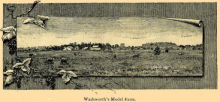You are here
Agriculture
This information was first published in 1888:
AGRICULTURE, SOIL, PRODUCTIONS, ETC.
We have now spoken of some of the chief attractions of the city of Charlotte, and we propose, by way of diversion, to give our readers a spin through the fields and woods of Mecklenburg, the richest county in the State, and give them a little talk upon subjects agricultural. The roads of the county are first rate, most of them being macadamized for some distance out from town, and as the touch of spring is just beginning to be felt and seen in the pale green of the swelling oak and poplar buds, the crimson of the maple and the dark rich green of the fields of clover, the ride will be a pleasant one. But first let us take a glance at this sketch of suburban landscape, being a view of Wadsworth's model farm taken from the St. Catherine gold mine.
The farm is located one mile from the city and is carpeted year in and year out with green, Mr. Wadsworth being a great believer in grasses and grain. He realizes two tons per acre of clover and lucerne, and he grows about 74 acres per year.
In our drive through the county we pass through a number of farms of the same character. The Double Oaks, of Gen. R. Barringer, Springdale, of S. B. Alexander, and the farms of Messrs. Baxter Moore, J. M. Davis, J. S. Myers, McD. Watkins, Philip Schiff, T. L. Vail, Joseph G. Shannonhouse, Jas. G. Harris, and D. P. Hutchison are particularly beautiful ones, and models of the modern Southern plantation home.
It is a delightful experience to take a drive through these splendid plantations oi the county, on one of our faultless spring days, when the air is rich in fragrance, and when—
"The hawthorn whitens and the juicy groves
Put forth their buds, unfolding, by degrees,
Till the whole leafy forest stands displayed,
In full luxuriance to the sighing gales."
The prospect is a pleasant one. Green fields meet the eye in every direction. The wave-like meadows are dotted with Alderneys, Jerseys, Holsteins and other improved breeds of cattle, and occasionally a flock of sheep is seen. The entire aspect of the country has been changed and improved by the adoption, some few years ago, of the no fence law, and one can travel mile after mile along a road that is bordered by fields of rustling corn, waving wheat or blooming cotton, with never a sign of a fence in sight. The cattle are fenced up in pastures, thus doing away with the trouble and expense of keeping up fences around the fields. The richest crops are now grown along the strips of land formerly taken up by the fences. The landscape is not only improved by the new order of things, but the farmers are annually saved a great expense.
No finer agricultural section can be found in the Piedmont belt. We have here both clay and sandy soils, principally a deep brown clay soil, which well repays the intelligent and industrious farmer for its cultivation, and when well prepared and properly tilled will produce to perfection cotton, corn, wheat, oats, rye and tobacco, sweet and Irish potatoes. The yield from any of the above per acre will be as large here as anywhere in our favored Southern land. Clover and the grasses also grow finely, and will readily produce from two to four tons of good hay per acre. Apples, pears, peaches, plums, and all the smaller varieties of fruits yield well, while grapes grow to perfection.
Our farmers, too, are beginning to catch the spirit of progress around us, and are abandoning the old slovenly ways of the agriculturalists of ante bellum times. They are taking more kindly to the improved methods, and are investing more and more every year in labor-saving machines. Mr. Baxter Moore, one of the most prominent farmers of the county, and one to whom we are indebted for a good deal of agricultural data, has tilled the soil in Mecklenburg for twenty years past, and says that he knows of no spot or section in all this broad land where he would be willing to emigrate with the view of bettering his condition. All the leading farmers say the same thing.
As much cotton can be raised here as anywhere in the cotton belt. The product of corn ranges from fifteen to fifty bushels per acre on upland; wheat fifteen to forty bushels; sweet or Irish potatoes, from two to four hundred bushels per acre, and oats fifty to one hundred bushels per acre.
Farming lands can be bought at from $10 to $30 per acre, according to situation and state of cultivation. In truth we know of no land that is blessed with a better climate, or that can offer more favorable inducements to the intelligent and industrious emigrant who may be looking around for a spot to settle down upon for life, than the lands in the vicinity of Charlotte.
Sketches of Charlotte, the Queen City of the Old North State, and Mecklenburg, the Banner County (Charlotte, NC: Charlotte Chamber of Commerce, 1888)
